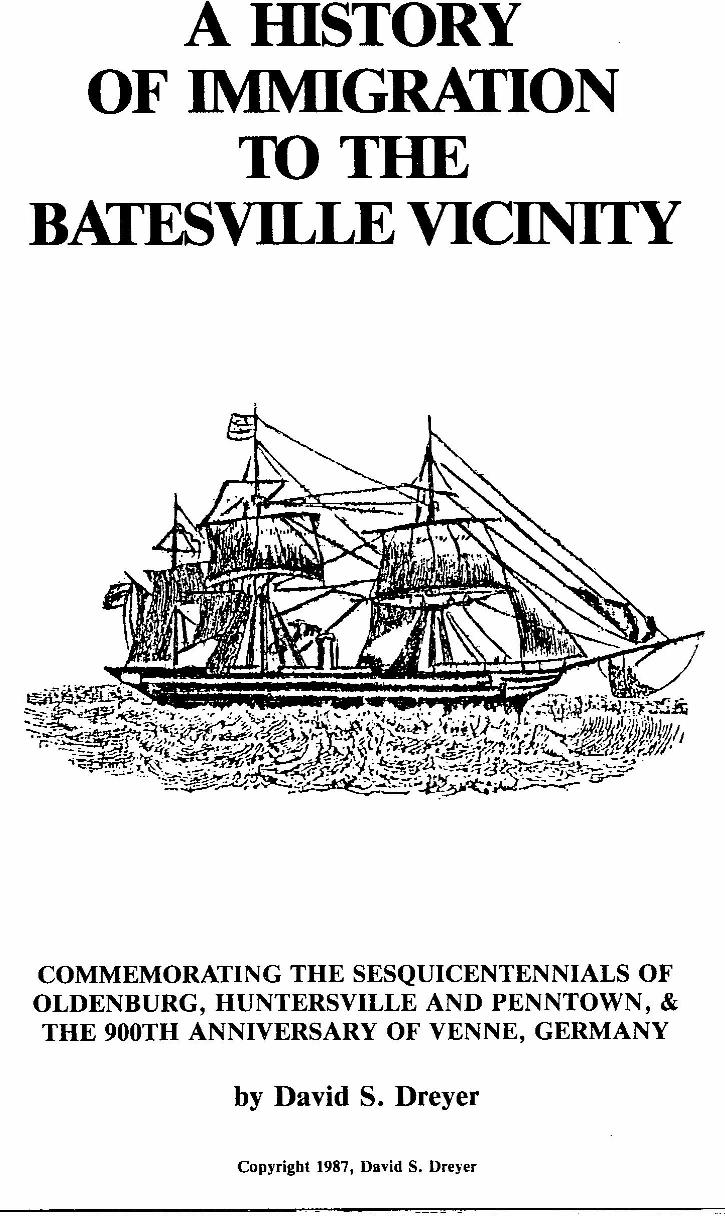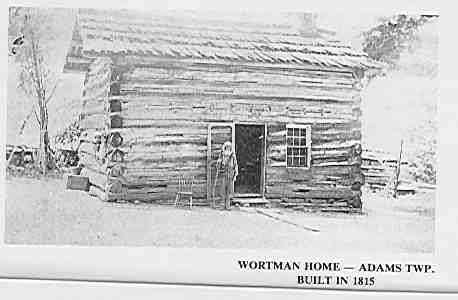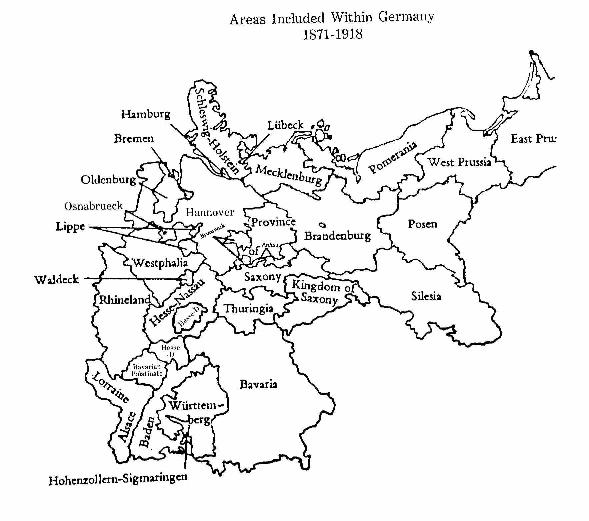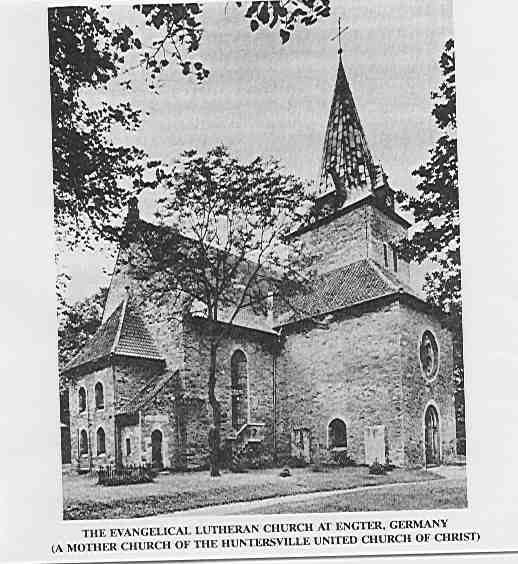

CHAPTER 1
SETTLEMENT OF THE BATESVILLE AREA


CHAPTER 1
SETTLEMENT OF THE BATESVILLE AREA
1987 marks the 150th anniversary of important events forBatesville, Oldenburg, and Penntown. For Batesville, it is the 150thanniversary of the founding of Huntersville Evangelical Protestant Church(now United Church of Christ). The founding of this church marksthe beginning of the community around which the Town of Huntersville wasplatted in 1841. Huntersville is the oldest part of present day Batesville.
For Oldenburg, 1987 is the 150th anniversary of both thefounding of Holy Family Catholic Church and the platting of the Town ofOldenburg. For Penntown, it is the 150th anniversary of the plattingof what was then called "Pennsylvaniaburg", the first town in Adams Townshipand "parent" of the Town of Sunman.
However, the history of these Batesville area communitiesdid not begin just 150 years ago in southeastern Indiana. This yearmarks the sesquicentennial of their Indiana history, but the history ofsome of these communities is six to eight times older than their historyin Indiana. For example, the Town of Venne, Germany, from which manyof the early settlers of Huntersville came, will celebrate its 900th anniversarythis year. That history had been forgotten in this country, but nowit is being rediscovered.
Many of the ancestors of Batesville area citizens werefirst Christianized about 1200 years ago. Much of the religion, diet,culture and values of Batesville area communities originated centuriesbefore the immigrants came to this country. Yet none of the extensivehistories written about this part of Indiana has provided more than a glimpseabout where these communities came from, what they brought to this country,and the major events that affected their development. That is thepurpose of publishing this new history.
Much of the settlement of the Batesville vicinity canbe traced back to three areas in northern Germany which were not very farfrom each other: Huntersville to Venne, Engter, Bramsche and surroundingcommunities just north of Osnabrueck in the Kingdom of Hannover; Oldenburgto Damme Parish about ten miles further north in the Grand Duchy of Oldenburg;and many German settlers in Adams and Laughery townships to HeiligenfeldeParish about forty-five miles further northeast in the Kingdom of Hannoverjust south of Bremen.
However, the settlement of this area was not exclusivelyby north Germans. Pennsylvaniaburg was named because many of itsearly settlers of English ancestry came from Pennsylvania. Penntownwas soon heavily settled by south Germans, particularly from Baden andthe Bavarian Palatinate. South German settlement was even greatereast of Penntown in northwestern Dearborn County.
The entire area around Batesville has long been proudof its German heritage, yet much of this heritage and history has beenignored or forgotten, particularly in the last 50 years. Some familiesin the communities around Batesville still have 3rd and 4th cousins livingin the boyhood homes of their great and great-great grandfathers who leftGermany 120 to 150 years ago, but few are aware of each other's existence.
Because this is the 150th anniversary of the foundingof Huntersville Church, Penntown, and the Town and Parish of Oldenburg,it is appropriate first to examine the history of both the German and non-Germanimmigration to this region of Indiana, and then to examine the Europeanhistory of the three areas in northern Germany which have played an importantrole in the development of Laughery, Adams and Ray townships.
This history should be of special interest to all thoseof German descent in this region and to the non-German community as well. It was this immigration which has determined much of the development andculture of this area.
EARLY NON-GERMAN SETTLEMENT
The Indians did not have any major settlements in southeasternIndiana at the time of white settlement. There were from time totime Indian encampments such as the one by the Shawnee Indians during thewinter of 1788 near the junction of Ripley and Laughery creeks in northernDelaware Township.
Significant Indian presence disappeared in the years afterthe Battle of Tippecanoe in 1811. The last meeting of Indians inthis area reportedly occurred in 1833 near Metamora where about forty gatheredfor the last time before being removed further west.
The earliest non-Indian settlement of this area was byEnglishmen and people of English and Irish descent from eastern statesand Kentucky. White settlement of this area came primarily throughDearborn County, although some settlers came to Napoleon by way of Madison.
Families settled near Lawrenceburg as early as 1796. In 1800 the Indiana Territory was established, and Lawrenceburg was plattedin 1802. Gradually settlement extended north along Tanner's Creekand then up the ridge to Yorkville, New Alsace, Hubble's Corner, and Penntown. Another route followed the road from Lawrenceburg to Napoleon.
Other settlement routes went north up the Whitewater Rivervalley towards Brookville and east from Aurora towards Versailles. John Conner established trading posts near Cedar Grove in 1803 and at Connersvillein 1808. However, those routes did not directly affect the Batesvillearea.
In about 1811 some of the Alley brothers from Virginiasettled along Pipe Creek in Franklin County. Martin Ewbank and hisson, John, settled a mile north of Guilford in the same year. JohnKelso from Ireland settled 3/4 of a mile northeast of present day Doveras early as 1813.
In 1814 Daniel and Henry Wooley settled in Shelby Townshipof Ripley County becoming the county's first white settlers. In 1815Richard and Dorcas Wortman from Kentucky settled five miles west of Sunman,and Robert and Nansy Johnson had settled in the Penntown vicinity by thesame year.
David Perrine of New York City arrived in the Yorkvillevicinity in 1816, the same year Indiana became a state. Also thatyear the Osburn family arrived in the vicinity of St. Mary's in FranklinCounty. In 1817 William George and his brother settled in Ray Townshipnear present day Oldenburg.
The Lawrence family from Pennsylvania settled around Lawrencevilleby 1818 where a United Bretheren Church was established nearby in 1819or 1820. John Sunman, Sr. and his son Tom arrived in 1819 from Holtbynear York, England. They settled west of Penntown where he, his wifeEllen, and two sons are buried on the point across the lake-in Indian Lakescampground.
Napoleon was among the earliest settlements in the areahaving been platted in 1820. It was located at the junction of theMichigan Road from Madison to Indianapolis and the road from Lawrenceburgto Napoleon. The Elias Conwell house built in 1822 at that junctionis still standing as is the nearby Central Hotel built about the same time.
Many of the early churches in Dearborn and Ripley countieswere Methodist or Baptist. The Baptist Church was particularly strongamong New Englanders. A Baptist Society was established in the Penntownarea in 1823 as a branch of the Little Cedar Grove Baptist Church southof Brookville. It became the Pipe Creek Baptist Church in 1832.
Franklin Baptist Church was established south of presentday Negangard's Corner in 1823 as a branch of 2nd Manchester Baptist Churchat Hogan Hill. The Methodists also began meeting in various homesand schools around Clinton about 1830. St. Paul's Methodist Churchsouth of Sunman is the outgrowth of this organization.
The first Catholic Church in southeastern Indiana wasbuilt at McKenzie's Crossroads (Dover) in 1824 by Irish Catholics fromMaryland. They had established a congregation there as early as 1820. Just east of Dover is an area still known as "Tipperary".
SOUTH GERMAN SETTLEMENT
Some Germans had been among the earliest settlers in thisvicinity. Phillip, Casper, and Jared Michael from Baden purchasedland one mile southeast of present day Weisburg in 1817 and 1818. They were part of the first large German migration to America in the 19thcentury.
These immigrants of 1817 had suffered a series of disastrouscrop failures culminating in unusually extreme weather in 1816, "the yearwithout a summer". The immigration was a spontaneous movement drivenby panic and despair.
A sense of restlessness and instability had also beencreated by the Napoleonic Wars which the restoration of the old regimesin 1815 could not subdue. Many of the immigrants came from southwesternGermany where Napoleonic sentiment was particularly strong. The areaof heaviest emigration was from the Dreisamkreis around Freiburg, Baden.
Crops improved in southern Germany in the fall of 1817,and many of the people who had attempted to leave experienced great difficultiesand failed to reach America. Consequently, emigration became unpopular,and it was not until around 1830 that Germans once again began to migrateto America in any great numbers.
In December of 1833, Thomas W. Sunman, the son of JohnSunman, Sr. wrote to his brother John in Cincinnati, "I hear there is moreDutch in these parts, tho' some that are here are already discouraged havingspent his money in land, has no friends or any thing to live on." In Januaryof 1837, Mr. Sunman wrote that he was buying land at sales in competitionwith the German immigrants.
Many of the German settlers of the 30s also came fromBaden in southern Germany and from Alsace, then in western France. Others came from Bavaria, the Bavarian Palatinate (or Rhein Pfalz), HesseDarmstadt,Wuerttemberg, and Switzerland. Once again the crops in the grape-growingregions of southern Germany had failed. The years 1830 and 1831 werealso marked by cholera, political upheaval and turmoil throughout Europe.
The southern German immigrants were mostly small farmerswhose lands had been divided and subdivided through divisible inheritances. They were people who had some possessions, but they were afraid of losingwhat little they had.
This time, once the immigration began, it did not stop. The successful immigrants wrote home in the words of the German poet Goethe,"Amerika, du hast es besser!" These immigrants to southeastern Indianafrom southern Germany were primarily, but not exclusively, Catholics.
A small community of Catholics from Grosswallstadt innorthwestern Bavaria (between Frankfurt and Wuerzburg) settled around St.Peter in 1833. German settlement from Alsace occurred around Yorkvillewhere Mass was first celebrated in 1833, around New Alsace where a CatholicChurch was established in 1833, and around Hubble's Corner where a LutheranChurch was also established in the year 1833.

Protestant settlement from the Palatinate, Baden and Wuerttembergis seen around Blue Creek at St. Jacob's Evangelical Protestant Church(now U.C.C.) which was established in 1838, and at its sister church, St.John's at Pennsylvaniaburg, established in 1840-41.
Catholics from Baden, particularly from Offenburg, establisheda church at St. Nicholas west of Sunman in 1836 and at St. Pius furthersouth in 1854. Protestants from Baden also settled along the Napoleon-Lawrenceburgroad. German Catholics who settled in 1840 around Morris (then calledSpringfield) came from both Baden and Oldenburg, Germany. They attendedeither St. Nicholas or the Holy Family Church at Oldenburg until St. Anthony'scongregation was established at Morris in 1856.
NORTH GERMAN SETTLEMENT
By 1837 many of the more recent immigrants were comingfrom northern Germany. Some of these immigrants were particularlyaffected by enclosure of common lands and by difficulties in the cottagelinen-making industry around Osnabrueck caused by the industrial revolution. In 1837 a financial panic struck U.S. cities, prices of farm commoditiessoared, and German immigrants in Cincinnati headed towards the countrysidefor the security of land.
Much of the immigration to Laughery, Ray and Adams townshipscame from the area along the irregular border between the Grand Duchy ofOldenburg and the Kingdom of Hannover on a line between the cities of Bremenand Osnabrueck. Three groups came in large numbers:
North German Catholics, particularly from the area aroundDamme in the Grand Duchy of Oldenburg, settled around Oldenburg, Indiana,beginning in 1835. Between 1830 and 1849 some 3,440 emigrants leftDamme. A copy of a list of their names is available at the BatesvillePublic Library.
The second group of immigrants to these three townshipscame from the Protestant communities surrounding Damme. They establishedHuntersville Church just a few miles south of Oldenburg, Indiana, in 1837. These Protestant settlers at Huntersville came from towns which form ahorseshoe around the western, southern, and eastern sides of Damme Parish. Many of them came from the towns of Bramsche, Engter, and Venne on thesouthern side of that horseshoe.
Thus Huntersville and Oldenburg families were neighborsback in Germany. The ties between these two communities are muchdeeper than commonly realized.
In the 1840s a third group of immigrants from the Syke-Heiligenfelde-Wachendorfvicinity south of Bremen settled west of Hubble's Lutheran Church nearpresent day Sunman. They also established St. Stephen's LutheranChurch near what is now Spades in 1843 and Adams Lutheran Church in thesouthwestern corner of Adams Township in 1852.
Some of this immigration from the Syke-Heiligenfelde regionwas caused by a potato blight, particularly around 1845 and 46. Thisblight affected much of northern Europe. Immigrants from the Sykevicinity also settled around Fink's Evangelical Protestant Church northof Osgood and around the Lutheran Church at Napoleon.
Because these three groups were particularly significantaround Batesville, the third and fourth chapters in this history will focuson their north German heritage. The next chapter will continue thestory of immigration to the Batesville area until the present day.
